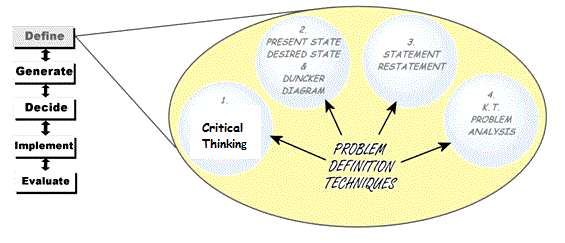

| Problem Definition Techniques | top |
In Chapter 1, we described situations in which millions of dollars were wasted when individuals defined the perceived problem instead of the real problem. In this chapter, we address the first part of the problem-solving heuristic-problem definition. We present four techniques that will greatly enhance your chances of defining the real problem.
| Duncker Diagrams | top |
The Duncker diagram helps us obtain solutions that satisfy the present state/ desired state statements. (Note: present state/desired state statements can be found in the Professional Reference Shelf
The unique feature of the Duncker diagram is that it contains two major pathways (general solutions) to go from the present state (the problem statement)
to the desired state (an acceptable problem solution).

| Statement-Restatement Techniques | top |



| K.T. Problem Analysis | top |

Due to electronic copyright restrictions, the reader is referred to the text material for which copyright
permission has been granted.
| Which Technique to Choose? | top |
We do not expect you to apply every problem definition technique to every situation. In fact, when 400 problem solvers were surveyed as to which two techniques presented in this chapter were the most useful to them, their choices were virtually equally divided among those presented in this chapter. In other words, different techniques work better for different individuals and different situations, and your selection of a problem definition technique is a matter of personal choice. The main point is to be organized as well as creative in your approach to problem definition.
| Deciding if the Problem Should be Solved | top |
